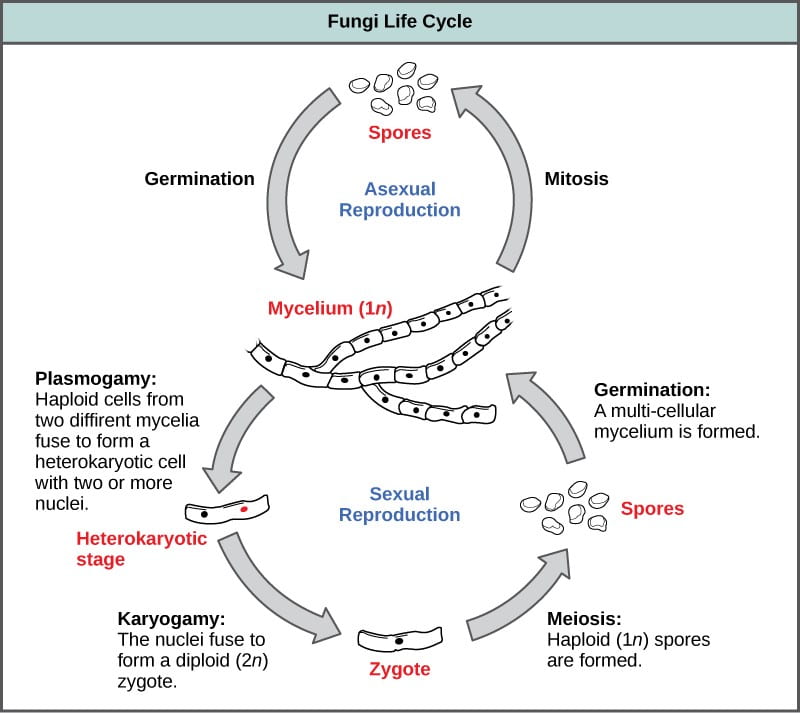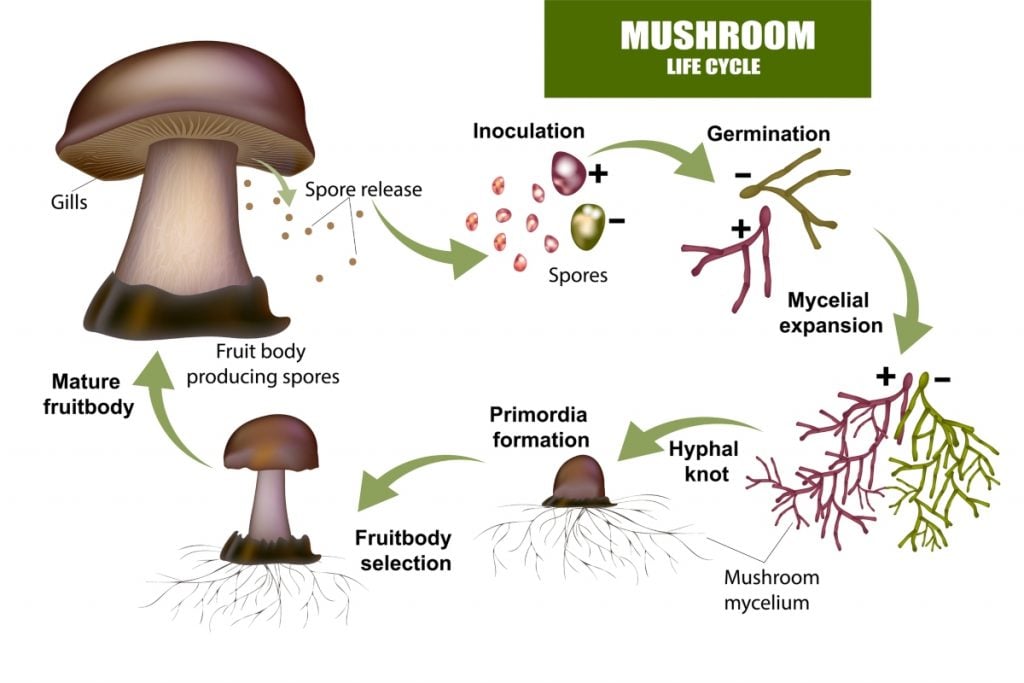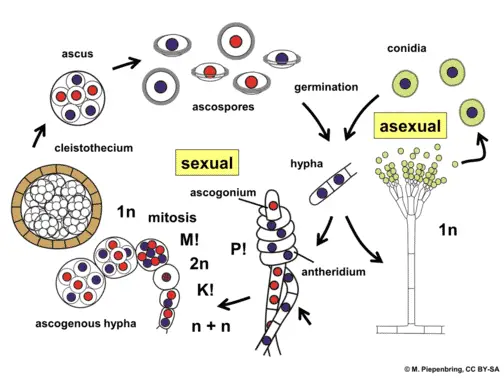fungi life cycle explained
A yeast-like fungus commonly occurring on human skin in the upper respiratory alimentary and female genital tracts. The pseudohyphae can give rise to yeast cells by apical or.
To form n gametes n.

. Ad Browse Discover Thousands of Book Titles for Less. The generalized life cycle of fungi. Not all fungi reproduce in the same way.
Mushroom spores are tiny microscopic reproductive units that are produced by fungi as well as some types of plants and algae. By producing vast numbers of spores both sexually and asexually so in TWO parts of life cycle Major difference from plants. This fungus has a dimorphic life cycle with yeast and hyphal stages.
The haploid phase ends with nuclear fusion and the diploid phase begins with the formation of the zygote the diploid cell resulting from fusion of two haploid sex cellsMeiosis reduction division restores the haploid number of chromosomes and initiates. Spore germ hypha mature mycelium. Fungi cells have a nucleus and organelles like plant and animal cells do.
But this model provides a good overview in terms of how fungi grows from birth to death. In this article we will discuss about the life cycle of ascomycetes explained with the help of a suitable diagram. This primordia is visible to the naked eye which means all the hard work is about to pay off.
This is the first stage in the life cycle of a fungus. Fungi store their food in the form of starch. Fungi must leave their food to find more and they do this not as hyphae but as spores.
Fungi replicate sexually andor asexually. Life cycle of The life cycle of fungi can follow many different patterns. The mycelium is the root structure of a fungal speciesone stage of a fungi life span that branches throughout the Earths crust creating an underground interconnected network that connects.
The life cycle of fungi has many different patterns based on the species of the fungi. While some fungi reproduce sexually others reproduce asexually. With the elongation of the germ tube most of the mitochondria migrate into it and become concentrated near the tip.
The fungi which reproduce sexually have alternating haploid and diploid phases. Fungi reproduce sexually either through cross- or self-fertilization. In this article we will discuss about the life cycle of ascomycetes explained with the help of a suitable diagram.
To form n gametes n. Some fungi are single-celled while others are multicellular. You can think of the spore phase as both the beginning and end of a mushrooms life.
Life Cycle of Fungi. Spore germ hypha mature mycelium. The mode of asexrual reproduction.
Mushrooms create what is called a mycelium network. An Overview The fungi kingdom is an essential part of the Earths ecosystem and integral for its health and survival. Single-celled fungi are called yeast.
The first sign of an emerging mushroom is a hyphal knot. Spores produced both. Life cycle of fungi.
Perfect fungi are sexually and asexually replicated whereas imperfect fungi are only asexually reproduced by mitosis. For most of the molds indoors fungi are considered to go through a four-stage life cycle. Spores are tiny cells that form on special hyphae and are so small that more than 1000 would easily fit on a pinhead.
In both sexual and asexual reproduction fungi develop spores that either fly on the wind or take a ride on an animal dispersing. The life cycle of fungi has many different patterns based on the species of the fungi. Haploid hyphae produce gametes which fuse by plasmogamy and karyogamy to produce diploid zygote.
Most of the molds indoors are considered to go through a four-stage life cycle. But this model provides a good overview in terms of how fungi grows from birth to death. There are four basic steps in the life cycle of a fungi.
Ad Over 27000 video lessons and other resources youre guaranteed to find what you need. Despite their diversity in many features the Ascomycetes possess certain common unifying characteristics namely the somatic body composed of a loose indefinite mass of septate mycelium. In the life cycle of a sexually reproducing fungus a haploid phase alternates with a diploid phase.
Fungi are eukaryotic non-vascular non-motile and heterotrophic organisms. The majority of mold. Terms in this set 21 Fungi unique for.
Being so small and lightweight spores can easily move unseen in the air currents and most fungal spores are spread by the wind. The yeast produces hyphae strands and pseudohyphae. This is when mycelium comes together to form a knot near the surface of the soil which will soon develop into a primordia aka baby mushroom cute.
Here the haploid spores produced from zygote germinate to produce haploid mycelia. Brundrett 1990 showed the same cycle pattern using an alternative diagram of the developmental stages of a mould. Some fungi alternate between single-celled yeast and multicellular forms depending on what stage of the life cycle they are in.
Great yeast bud scars and pseudohyphae.

A Detailed Explanation Of The Mushroom Life Cycle Grocycle

Reproduction In Fungi Life Cycle Of Fungi Youtube

Zygomycota The Conjugated Fungi Biology For Majors Ii

Sexual Life Cycles Article Meiosis Khan Academy

24 1c Fungi Reproduction Biology Libretexts

Life Cycle Of Fungus Black Bread Mold Rhizopus Stolonifer Youtube

Ascomycota The Sac Fungi Biology For Majors Ii

Characteristics Of Fungi Openstax Biology 2e

Diagrammatic Representation Of Mushroom Life Cycle Download Scientific Diagram

Fungi Reproductive Cycle Diagram Quizlet

Life Cycle Of A Mushroom Worldkids

Life Cycle Of An Am Fungus And The Different Steps During Am Development Download Scientific Diagram

Basidiomycota Part 2 The Mushroom Life Cycle Youtube

Fungi Explained Here Is What You Need To Know Microscope Clarity



